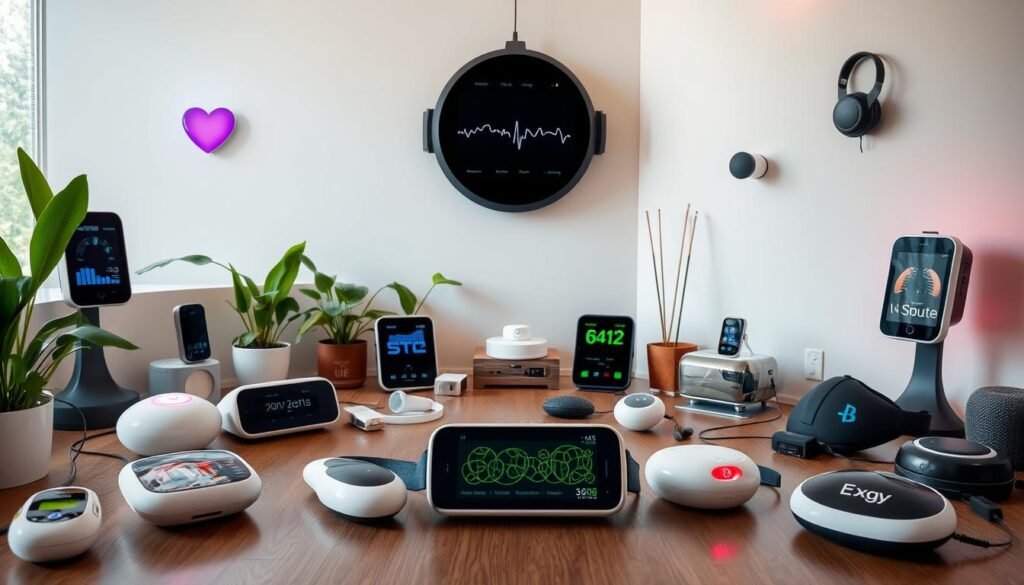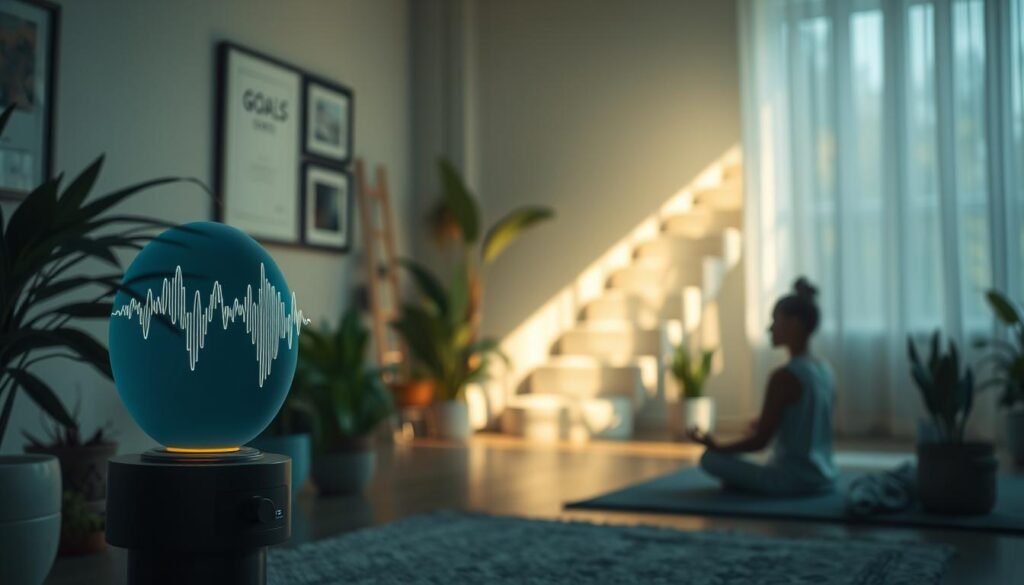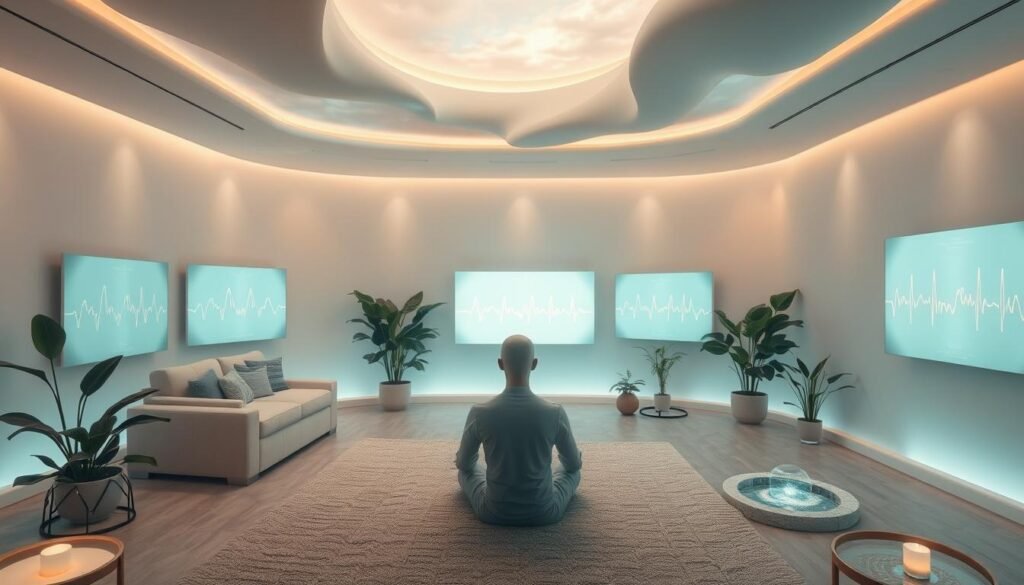Did you know about 40 million adults in the US face anxiety disorders each year? This big number shows how much we need effective treatments. People are looking for ways to calm their anxiety naturally. Biofeedback for anxiety is getting noticed. It uses the mind-body link to help people handle their anxiety better.
Biofeedback watches physical responses like heart rate and muscle activity. It’s a gentle way to learn about your body’s reactions. It also gives you ways to manage anxiety better. As more people look for natural and whole health options, biofeedback is becoming a bright light. It offers hope for managing anxiety without just using medicines.
Learning how biofeedback works can show its power for natural anxiety relief. By trying this whole approach, many find a way to more self-knowledge and emotional strength.
Key Takeaways
- Biofeedback helps people watch and change physical signs of anxiety.
- It’s a non-harsh choice for natural anxiety relief.
- The connection between mind and body is key to managing anxiety.
- Studies show biofeedback can make emotional health better.
- This method lets people feel they have more control over their mental health.
Understanding Biofeedback
Biofeedback is a cool method to help you be more aware and control your body’s responses. It lets you understand how your body works. You can then use techniques to influence these functions. It creates a strong link between how you think and feel and your physical health.
Definition and Overview
Biofeedback involves using sensors to gather information on how your body responds to things like stress. Sensors track your heart rate, muscle tension, and how you breathe. This information helps you learn to handle your body’s reactions better. The tools used can range from pulse monitors to devices that track brain waves.
The Mind-Body Connection
This therapy hinges on the strong link between your mind and body. It uses real-time feedback to teach you how to control bodily functions. You might see visual cues or hear sounds that guide you. It’s about understanding how relaxing, breathing differently, or being mindful can make you feel better overall.
| Physiological Response | Monitoring Sensor | Feedback Method |
|---|---|---|
| Breathing Rate | Bands around the stomach/chest | Visual audio signals |
| Heart Rate | Pulse sensors/EKG | Vibrations |
| Muscle Tension | sEMG sensors | Virtual reality feedback |
| Sweat Levels | GSR on fingertips/palm | Auditory feedback |
| Brain Activity | EEG on scalp | Graphic patterns |
| Skin Temperature | Dedicated sensors | Visual/auditory cues |
How Biofeedback Works
Biofeedback is a method that helps people understand and manage their body’s signals. It lets people know how their body reacts, helping them control stress and anxiety. By using different techniques, biofeedback lets people change their body’s state to feel more relaxed.
Monitoring Physiological Responses
In biofeedback sessions, people are connected to machines that measure things like heart rate and skin temperature. This is key as it gives instant feedback. It helps people learn about what their body does when stressed. This way, one can spot and manage stress early on.
Techniques to Regulate the Nervous System
There are many helpful biofeedback techniques. Deep breathing and progressive muscle relaxation are very useful. They help relax the body by calming the nervous system. Guided imagery is another technique that uses mental pictures to feel peaceful. These methods help greatly reduce anxiety and better mental health.
Using these techniques every day can help people deal with anxiety better. For more help, Cognitive Behavioral Therapy offers more useful strategies.
Biofeedback for Anxiety
Biofeedback is a key non-invasive way to treat anxiety. It is well-regarded by mental health experts and patients. This approach teaches how to manage anxiety symptoms. It focuses on controlling things like heart rate and muscle tension. Many studies show it helps with anxiety disorders such as GAD, panic disorder, and PTSD.
Effectiveness in Managing Anxiety Symptoms
Biofeedback training helps lessen anxiety. Studies show people see big improvements in their symptoms with it. Before treatment, many people felt highly anxious. After treatment, fewer people had severe anxiety. Most felt their anxiety was mild to moderate.
Research and Studies on Biofeedback
A lot of research backs up biofeedback for dealing with anxiety. It works because up to 90% of what our bodies do is automatic. Biofeedback helps people control these automatic functions. Tools used include EMG, GSR, HR, and EEG. Studies say using biofeedback with CBT makes treatment even better.
| Scale | Condition Before Biofeedback | Condition After Biofeedback |
|---|---|---|
| HAM-A Scale | 27.0% Mild to Moderate 16.5% Medium 56.5% Severe |
90.6% Mild to Moderate 5.9% Medium 3.5% Severe |
| SAS Scale | 42.4% Minimal to Moderate 21.2% Marked Severe 36.5% Extreme |
68.2% Normal 27.1% Minimal to Moderate 4.7% Marked Severe |
There’s strong proof that biofeedback is a solid anxiety treatment. It means people can rely less on medicine. As research continues, biofeedback’s role in mental health keeps growing. It offers hope to those wanting to manage their anxiety better.
Types of Biofeedback Techniques
Biofeedback offers various techniques that aim to ease anxiety. By training individuals to monitor and control bodily processes, each technique can help improve mental wellness. These methods are especially good for managing anxiety.
Heart Rate Variability Training
Heart rate variability (HRV) training tracks the timing between heartbeats. It improves emotional control by teaching people to manage their breathing. This results in lower anxiety and better stress management.
Neurofeedback Therapy
Neurofeedback therapy uses electroencephalography (EEG) to monitor brainwaves. It helps individuals control their brain activity, leading to clearer thinking and more stable emotions. It’s particularly useful for those with ADHD and autism.
Breathing Exercises for Anxiety
Breathing exercises are key in biofeedback for reducing stress. Techniques like deep breathing help lower heart rate and blood pressure. Doing these exercises daily enhances calmness, aiding in anxiety management.
Progressive Muscle Relaxation
Progressive muscle relaxation teaches how to lessen muscle tension. People learn to tense and relax muscles, easing anxiety symptoms. It’s a valuable part of treating anxiety, boosting overall mental health.

Benefits of Biofeedback Therapy
Biofeedback therapy is an excellent option for managing anxiety. It’s a safe, non-invasive method. Patients learn about their body’s responses, boosting awareness. This self-awareness brings many advantages.
Non-invasive Treatment Option
Many choose biofeedback because it doesn’t involve surgery or strong drugs. It teaches patients to control bodily functions naturally. This fits well with the trend towards natural health methods.
Potential to Reduce Medication Dependency
One key benefit of biofeedback is less reliance on medication. Those with anxiety or PTSD often see great improvement. Using fewer drugs means better overall health and fewer side effects.
Enhanced Self-Control and Awareness
Biofeedback boosts self-control over anxiety. It leads to a better understanding of the body’s stress reactions. With this knowledge, people can handle their anxiety better, improving mental health.
Common Equipment and Tools Used in Biofeedback
Biofeedback is a way to treat health by monitoring body functions. It uses different devices to help people know more about their health. Here are some popular tools used in biofeedback.
Heart Rate Monitors
Heart rate monitors are key in biofeedback. They check your heart’s rhythm and show your stress and feelings. This info helps people control their body reactions better. Studies say this can reduce stress and anxiety by improving breathing and relaxation.
Research also shows using heart rate feedback can lower blood pressure. It helps ease anxiety as well.
Thermal Biofeedback Devices
Thermal biofeedback devices track body temperature changes. These changes often signal stress. Seeing these changes helps users relax more. As stress drops, body temperature usually goes up. This helps in managing emotions and health.
Galvanic Skin Response Monitoring
This method checks the skin’s electrical conduct when we sweat. Sweating more can mean we’re anxious or stressed. It helps people understand and handle their stress better. This tool, along with others, is vital in coping with stress. It leads to improved mental health.
Using these biofeedback tools daily can help manage stress well. For those interested, there are resources on home biofeedback devices. These include meditation guides for better self-care. To learn more, have a look at this helpful resource about biofeedback devices.
Integrating Biofeedback into Your Anxiety Management Plan
Integrating biofeedback into your anxiety plan takes a whole-person approach. It combines biofeedback with mindfulness meditation and stress techniques. This leads to better emotional control and relaxation.
Combining with Mindfulness Meditation
Mindfulness meditation works well with biofeedback. It boosts self-awareness. This helps people notice how their bodies react to stress. Knowing this, they can use biofeedback better. With meditation, they focus on their inner state. This combo helps calm the mind and body in stressful times.
Implementing Stress Management Techniques
Adding stress techniques like yoga, breathing exercises, and journaling boosts biofeedback benefits. These help with relaxation and being mindful. It makes it easier for people to use what they learn from biofeedback. Doing these activities often helps the body’s changes last longer. This leads to better handling of anxiety. Studies show biofeedback and stress techniques work well together. They could be great for treating anxiety. You can find more on biofeedback benefits here.
Setting Realistic Goals with Biofeedback
Setting realistic goals is key for biofeedback therapy success. This makes a treatment plan more effective. It helps people focus on clear outcomes. By knowing their unique needs, individuals can pick the best biofeedback techniques.
This way, they can lessen anxiety symptoms significantly.
Establishing a Personal Treatment Plan
A personal plan outlines clear objectives. With specific goals, people can focus their energy better. It’s important to think about:
- Identifying specific anxiety triggers
- Setting timeframes for achieving goals
- Implementing techniques that resonate personally
Adjusting the plan as you go makes it more effective. This helps deal with therapy challenges better.
Tracking Progress Over Time
Tracking progress is essential. Journaling records insights and responses to biofeedback.
Checking on progress weekly or bi-weekly shows what’s working. This way, people can see their growth over time. This brings a sense of accomplishment.
| Tracking Method | Description | Benefits |
|---|---|---|
| Journaling | Documenting daily experiences, emotions, and techniques used. | Increases self-awareness and highlights patterns. |
| Progress Assessments | Regularly reviewing personal goals and achievements. | Identifies effective strategies and areas for improvement. |
| Biofeedback Session Reviews | Analyzing data and metrics gathered from sessions. | Enables informed adjustments to treatment plans. |
Setting realistic goals turns managing anxiety into a positive journey. Clear goals help with personal growth and motivation. This leads to better life quality.

Potential Limitations and Risks
Biofeedback therapy is often safe and helpful for many people. However, knowing the biofeedback limitations and risks of biofeedback is key before starting. This knowledge helps make smart choices about mental health and wellness.
Considerations Before Starting Treatment
Before starting biofeedback therapy, it’s smart to look at several treatment considerations. Some may have health issues that make biofeedback readings off. Also, not knowing how to read the data well can lead to wrong results. It’s wise to check with healthcare pros before deciding on biofeedback alone.
Inaccuracy in Readings for Some Individuals
Sometimes, biofeedback devices give wrong readings for certain people. This can happen for many reasons, like health issues or poor training. Telling your therapist all about your medical history is important. It helps spot any risks from health problems. Having real expectations about biofeedback can make the treatment more satisfying.
Finding a Biofeedback Therapist
Finding the right biofeedback therapist is crucial for treating anxiety effectively. It’s important to spend time asking potential therapists important questions. Understanding their background and skills can greatly affect your treatment. Make sure the therapist you choose fits your specific needs by researching their credentials.
Questions to Ask Potential Practitioners
Before psychotherapy starts, it’s wise to have a list of questions ready. These questions should reveal key details about the therapist’s qualifications and methods. Here are some important questions you might ask:
- What is your educational background and training in biofeedback?
- How many years have you been practicing biofeedback therapy?
- What types of biofeedback do you specialize in?
- Do you have any certifications from recognized organizations?
- How do you customize treatment plans for individual patients?
- What success rates have you observed with past clients?
Researching Credentials and Experience
To find a good biofeedback therapist, you need to do your homework on their qualifications. There are several ways to make sure you’re picking someone who’s truly skilled:
- Check for certifications from the Biofeedback Certification International Alliance, indicating adherence to the highest standards in the field.
- Look into the completion of required training hours, typically ranging from 24 to 50 hours for biofeedback coursework.
- Seek referrals from healthcare providers or individuals who have previously undergone biofeedback therapy.
- Read online reviews or testimonials from former patients about their experiences.

Taking these actions will help you confidently start managing anxiety with a competent biofeedback therapist.
Conclusion
Biofeedback is a great natural way to handle anxiety. It helps people become more aware of their bodies and control their reactions. This method doesn’t just rely on drugs to make you feel better. It looks at your overall health.
Studies show that biofeedback can really help reduce stress and anxiety. This is especially true for college students. They face a lot of pressure from school and money issues. Thanks to new technology, biofeedback is easier to use and more people can try it. Now, there are even fun multimedia and wearable devices for it.
If you want to learn more about how biofeedback helps with anxiety, check out some detailed studies here. Biofeedback is getting better all the time. It’s not only good for anxiety but also for boosting overall mental health.